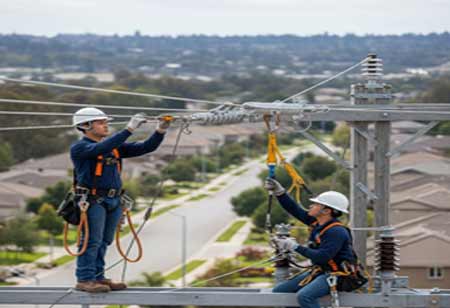Thank you for Subscribing to Electrical Business Review Weekly Brief
I agree We use cookies on this website to enhance your user experience. By clicking any link on this page you are giving your consent for us to set cookies. More info
Canada Adopts Smart Technologies in Electrical Distribution
The electrical distribution sector is enhancing resilience and customer engagement by integrating smart grids and renewable energy sources.

By
Electrical Business Review | Monday, June 30, 2025
Stay ahead of the industry with exclusive feature stories on the top companies, expert insights and the latest news delivered straight to your inbox. Subscribe today.
Fremont, CA: Canada’s electrical distribution sector is rapidly changing, driven by the need for smarter, more resilient, and sustainable energy systems. With growing demands for reliability and environmental responsibility, utilities are adopting advanced technologies and modernizing their infrastructure to serve their communities better. From integrating renewable energy sources and decentralized generation to building climate-resilient grids and empowering the workforce with digital tools, the industry embraces innovation to ensure secure, efficient, and future-ready power delivery nationwide.
Shifting Toward Smarter Grids and Decentralized Systems
Canada’s electrical distribution landscape is undergoing significant transformation, driven by growing demand for sustainability, reliability, and innovation. One of the most notable trends is the gradual shift toward smart grid infrastructure. These modernized networks utilize advanced sensors, communication systems, and data analytics to enhance efficiency, detect outages more quickly, and better balance supply and demand. By enhancing grid responsiveness, smart technologies facilitate the incorporation of renewable energy sources and enable real-time decision-making for utilities and consumers.
Another key development is the rise of decentralized energy generation. Distributed energy resources, including wind turbines, rooftop solar panels, and battery storage systems, are evolving and becoming increasingly common across Canadian homes and businesses. This shift encourages a two-way flow of electricity, where consumers use energy and produce and sell it back to the grid. Supporting this model requires an updated distribution infrastructure to handle variable inputs and maintain grid stability.
Demand response programs are also growing in popularity. These programs encourage users to reduce or shift their energy consumption during peak times, helping alleviate grid pressure. Digital metering and automated control systems enable real-time tracking of energy usage and dynamic pricing models, which are becoming increasingly common across provinces. This evolution changes how residential and commercial customers interact with their electricity providers.
The electrification of transportation and heating is also influencing distribution systems. More electric vehicles and heat pumps are entering the market, significantly increasing load demands in some areas. Distribution networks adapt through targeted upgrades, including reinforced substations, expanded transformer capacity, and improved demand forecasting tools.
Sustainability, Resilience, and Workforce Transformation
Environmental responsibility plays a central role in shaping electrical distribution strategies. Canadian utilities and service providers are incorporating more low-impact materials, reducing transmission losses, and pursuing carbon-neutral operations. Energy efficiency measures are embedded into the design and operation of substations and distribution lines. Vegetation management, weatherproofing, and climate-resilient infrastructure upgrades are crucial to enhancing grid resilience in the face of extreme weather and natural disturbances.
The push for sustainability also includes better lifecycle management of electrical components. This involves recycling materials from decommissioned equipment and incorporating circular economy principles into procurement and maintenance practices. These measures decrease environmental impact and contribute to long-term cost savings.
Digital transformation is reshaping the electrical workforce. Technicians and engineers are equipped with digital tools, including mobile apps, augmented reality interfaces, and remote diagnostics. These technologies streamline maintenance operations, reduce field time, and improve safety. Investment in workforce development is essential to ensure employees are trained to operate, maintain, and innovate within increasingly digital and automated systems.








